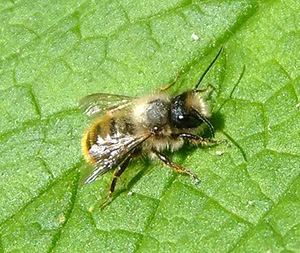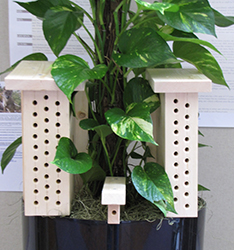Mason Bees
Mason Bees
By Environmental Management System
April, 2015
Have You Heard the New Buzz on Campus?

Photo courtesy of Sandy
How many types of bees do you think are out there? One native species you may not have heard about is the mason bee. Unlike the honeybees, mason bees are solitary insects. They don’t burrow or excavate cavities like carpenter bees, nor do they produce honey or beeswax. All females are fertile and there is no social order like traditional bee colonies; individual bees rely on woodpecker holes, beetle grub tunnels, and small crevices and cavities for nesting sites. Mason bees can play an important role in early spring fruit tree and berry pollination, especially when local honeybee populations are in decline.
Life Cycle of the Mason Bee
In the spring, when the temperatures reach into the mid-50s, the male mason bees emerge from the nesting cavity before the female mason bees. The mason bees warm in the sun and provide some pollination for nearby plants and flowers. As the female bees emerge, they mate immediately; soon after mating, male bees die.

Photo courtesy of Bill Willis
Alone, females have just six weeks to collect pollen and nectar and to construct the nest chambers before they too die. They begin constructing individual egg cells in the nesting chamber, using soil and chewed plant tissue to construct the chamber walls. The female bee mixes pollen with saliva to create a sticky, gooey substance in which to lay the egg; this is later used as a food store for larva. This egg cell is then closed off and the process repeats until the nest tube is filled with individual egg chambers. Female eggs are deposited at the rear of the tube, while male eggs are deposited closer to the opening; male eggs and larva are the first line of defense if the nesting tube is attacked by a predator during the incubation process.
Over the summer, the larva hatch and eat the food store; they then spin a cocoon in late summer, where the adult bee matures and hibernates. The cycle then begins again with new bees in the spring.
Mason Bees on Campus
The NIEHS has built mason bee nest blocks that will be placed on campus later this year. Each year, nest blocks will be cleaned and sanitized to reduce the chance of mites, as well as monitored for parasites, and possible diseases. Male mason bees do not sting, and female mason bees will only sting if harassed.
Although the EPA has had nest blocks on campus for five years, they have not monitored mason bee population changes, so this is a great opportunity to monitor the growth of the mason bee on our campus and encourage plant pollination.
For more information:
- How to Build a Bee House by the National Wildlife Federation
- Blue Orchard Mason Bee by the USDA Department of Forestry



